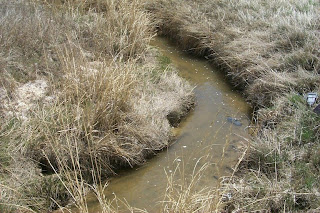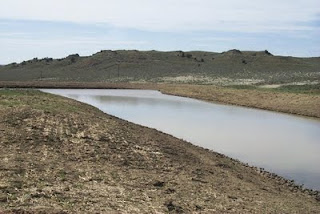I’ve been working hard all summer on legislative stuff, constituent requests, and civic issues, and one of my focii has been water–water quality, water quantity, and our stewardship of our waters in all the ways we use it.
I serve on the board of directors of the Greater Gallatin Watershed Council and in June released a report on E. Coli contamination in Bozeman Creek. There are public health cautions about drinking or playing in the water. I often say it’s a heck of a lot easier to keep something bad out of our water than to remove it once it’s in there, and a public health threat indicator like E. Coli garners our attention and action.
I’m proud to serve in this legislative interim on the Water Policy Interim Committee, and I’ve been studying water policy related to coal bed methane (CBM) drilling. I’ve written on this before (see my entry of March 30) but now, our neighbors to the North (Alberta and British Columbia, Canada) and to the South (one state removed, Colorado) have found that water is a precious resource that merits protection and is not simply a byproduct of a mining practice.
Alberta requires reinjection of groundwater aquifers after water is pumped out to release the pressure holding the methane in place, so that the methane can then be extracted.  In April, the Colorado Supreme Court found that CBM producers must adhere to the same water rules and regulations as other state water users, and that the extraction of tributary groundwater for coal bed methane production is a “beneficial use” of water that is subject to water rights administration and approvals by the water courts.
In April, the Colorado Supreme Court found that CBM producers must adhere to the same water rules and regulations as other state water users, and that the extraction of tributary groundwater for coal bed methane production is a “beneficial use” of water that is subject to water rights administration and approvals by the water courts.
These are two precedents–more than that, actually, they’re laws and statutes–that recognize the importance of water quality and quantity and require other processes to respect the importance of water.
Alberta also has requirements for drilling companies to determine baseline data and to establish monitoring wells before drilling ever begins, prohibits the injection of fracturing (or fracking) liquids (like diesel fuel) into the ground to break apart coal or to loosen the ground, and requires CBM extractors to reinject produced water back into the ground.
Think of this in the context of other mining operations. Take, for instance, strip mining coal. For a coal seam seventy feet deep in the ground, a company removes the topsoil, rock, clay, loam, and other material that lies on top of the coal, and that material is called the “overburden”. The topsoil and clay and loam and other stuff is piled up, put aside, and the company mines the coal seam. They then RECLAIM the site by REPLACING the overburden in the strata in which it originally lay, grade the site, and return it as closely as possible to its original state.
 Water is the overburden that is removed in CBM production. At the end of the CBM mining, the overburden should be returned.
Water is the overburden that is removed in CBM production. At the end of the CBM mining, the overburden should be returned.
Water users dependent upon, or with water rights to, groundwater must not have that groundwater pumped off and released to surface waters, never to be available from that underground aquifer again. It’s not fair.
Canada and Colorado have established that CBM mining must recharge the aquifers and treat water as a resource, not a waste product of mining.
 The Colorado Supreme Court determined that the extraction of tributary groundwater for coal bed methane production is a “beneficial use” of water that is subject to water rights administration and approvals by the water courts. The findings of the case, Vance v. Wolfe, state, among other things, that the water that holds the coalbed methane under pressure in coal seams, holding it in place, is a beneficial use of the water, and that coalbed methane can be extracted BECAUSE of hydrostatic pressure. If the water were not holding the methane in place, the methane couldnt be extracted. The water itself makes CBM production possible, and that lends value to the water, as well as by virtue of the importance of water itself.
The Colorado Supreme Court determined that the extraction of tributary groundwater for coal bed methane production is a “beneficial use” of water that is subject to water rights administration and approvals by the water courts. The findings of the case, Vance v. Wolfe, state, among other things, that the water that holds the coalbed methane under pressure in coal seams, holding it in place, is a beneficial use of the water, and that coalbed methane can be extracted BECAUSE of hydrostatic pressure. If the water were not holding the methane in place, the methane couldnt be extracted. The water itself makes CBM production possible, and that lends value to the water, as well as by virtue of the importance of water itself.
The court decision reads, in part: “the presence of water and its subsequent extraction during CBM production is far more than an “inevitable result.” Indeed, the presence and extraction of water are integral components to the entire CBM process. CBM producers rely on the presence of the water to hold the gas in place until the water can be removed and the gas captured. Without the presence and subsequent extraction of the water, CBM cannot be produced. As both Three Bells and Zigan make clear, the fact that the water used during the CBM process may become “a nuisance” after it has been extracted from the ground and stored in above ground tanks (that is, after it has been “beneficially used”) does not prevent a finding that the water is put to a beneficial use. While the Engineers and BP are correct that no Colorado case has specifically held that water used during CBM production is a beneficial use, this fact does not prevent us from finding such a beneficial use where our case law and the language of the 1969 Act so dictate.
That the water used in CBM production is integral to the process itself distinguishes this case from a host of other instances in which nuisance water is merely removed but not beneficially used. The Engineers and BP argue that the use of water in CBM production is akin to snow removal, removal of flood water from a subsurface mine, and storm water control at construction sites — all of which constitute mere removal of nuisance water rather than beneficial uses. We find the analogy attempted by the Engineers and BP to be a faulty one. In their examples, the water is exclusively a nuisance and not integral to the task at hand. In contrast, CBM production cannot occur without the presence and controlled removal of the water.”
Our Montana Constitution says, “The waters of the state are the property of the state for use by its citizens.” It’s our responsibility to protect these waters, to make beneficial use of them, and not to waste water. We’re a headwaters state; there’s no water upstream from us, so when we go dry, that’s it (until the next snowfall and melt season). Good and protective precedent is set by our neighbors to the north and (one state removed) south.
I’ll work to make sure Montana’s waters are well and responsibly used–and restored.